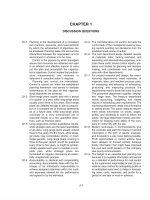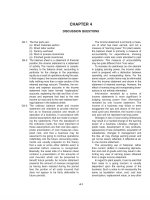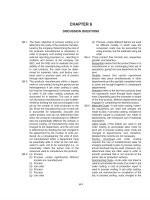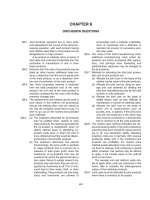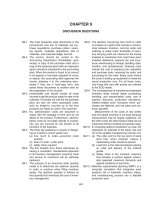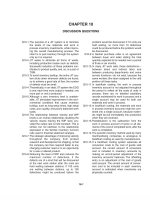Solution manual cost accounting by carter 14e ch22
Bạn đang xem bản rút gọn của tài liệu. Xem và tải ngay bản đầy đủ của tài liệu tại đây (70.57 KB, 30 trang )
CHAPTER 22
DISCUSSION QUESTIONS
Q22-1. Effective planning and control of capital
expenditures are important because:
(a) financial risk is increased by long-term
commitments;
(b) the magnitude of capital expenditures is
substantial and the penalties for unwise
decisions are usually severe;
(c) decisions made in this area provide the
supporting structure for operating activities of the firm.
Q22-2. Examples of opportunities and temptations
for unethical behavior in the capital budgeting
area include:
(a) pressure applied to the cost/managerial
accountant by superiors or associates to
circumvent the capital expenditure
approval process, in order to get a pet
project approved;
(b) pressure to write off or devalue assets
below their true value in order to justify
replacement;
(c) exaggerating the expected economic benefits of a pet project in order to increase the
likelihood of getting it approved
Q22-3. The cost/managerial accountant has an obligation to the company to make sure that the
company’s legitimate policies and procedures
are not circumvented and to make sure that
the data used in the evaluation of capital
expenditure proposals are as reliable and
realistic as possible. If an ethical violation
occurs, the cost/managerial accountant
should first discuss the perceived problem
with his or her immediate supervisor (in order
to clarify the significance of the problem and
identify possible courses of action) and then
with the individual or individuals involved. If
the individual involved is the accountant’s
immediate supervisor, the cost/managerial
accountant should consult the next higher
level of management. If the problem cannot
be resolved through discussion, the
cost/managerial accountant is obligated to
provide a full disclosure of all the details to the
executives responsible for evaluating and
approving capital expenditures.
Q22-4. The economic life of a project is the period
during which it produces earnings. It need
not, and probably will not, be equal to the
physical life of the related asset(s). Its length
depends primarily upon the obsolescence of
the product or manufacturing process
involved or the nature of the product itself.
Managers usually find it quite difficult to estimate economic life because it depends upon
future events over which they may have little
or no control.
Q22-5. Cash outflows that might be expected for a
capital expenditure include:
(a) purchase price of one or more assets (or
a down payment if property is purchased
on installment);
(b) construction period interest and taxes if
the property is being constructed;
(c) machinery and equipment setup cost,
particularly if machinery being evaluated
utilizes a more advanced technology than
that currently in use;
(d) computer software development cost if a
computer aided design, computer aided
manufacturing, or fully computer integrated manufacturing system is being
purchased;
(e) increased annual maintenance and/or
power costs resulting from more complicated or technologically advanced machinery or equipment;
(f) lease payments, if some or all of the
assets being acquired in the project are
leased;
(g) working capital requirements (inventory,
cash on hand, receivables, payables,
etc.) may increase as a result of
increased business generated by the
capital project.
Q22-6. Cash inflows that might be expected from a
capital expenditure include:
(a) revenues from additional business generated by the project;
(b) cost savings created by the capital expenditure that result in a reduction of cash
outflows (e.g., maintenance savings,
22-1
22-2
labor savings, reduced inventory requirements resulting from reduced setup
times, etc.);
(c) retention of market share that might have
been lost if the capital expenditure were
not made (particularly in the case of
advanced technologies that improve
product quality, reduce costs, provide
manufacturing flexibility, etc. that can provide a competitive advantage to the firm
with the technology);
(d) salvage from the sale of the property at
the end of the economic life of the capital
project.
Q22-7. Some nonquantifiable benefits from investing
in advanced manufacturing technologies,
such as CIM, FMS, and robotics, include:
(a) improved product quality (ability to meet
closer production tolerances and at the
same time reduce the variability in production output);
(b) decreased machine setup and shorter
manufacturing cycle times (which provide
the company with the ability to adjust output quantity and variety quickly to meet
rapidly changing customer demands).
Q22-8. Tax depreciation is quite likely to differ from
book depreciation because the cost recovery
period used for tax purposes is usually
shorter than the economic life of the asset
used for financial accounting purposes. Also,
an accelerated method of depreciation is typically used for tax purposes, whereas the
straight-line method is more often used for
book purposes.
Q22-9. Book depreciation should not be considered
in estimating the future cash flows from a project because book depreciation has no effect
on the amount or timing of cash flows.
Q22-10. Tax depreciation should be considered in estimating the future cash flows from a project
because tax depreciation reduces taxable
income and, therefore, tax liability. Tax depreciation results in a tax savings, i.e., a reduction
Chapter 22
of tax liability that is a cash outflow. The timing
of cash flows is affected by the tax depreciation
method and the recovery period used.
Q22-11. Financial accounting data are not entirely
suitable for use in evaluating capital expenditure proposals because:
(a) Financial accounting uses the accrual
basis. Capital expenditure decisions generally rely on estimates of cash flows,
rather than revenues and expenses
determined on the accrual basis.
(b) Financial accounting is designed to
measure periodic earnings. Capital
expenditure evaluation is concerned with
the life of a given project, which seldom
corresponds to usual accounting periods.
(c) Financial accounting measures the
results of operations of a company or a
segment of a company. Although this
entity sometimes corresponds with a capital expenditure project, it is usually composed of many intermingled capital
expenditure projects.
(d) Financial accounting capitalizes expenditures if the expenditure is deemed to have
a future value or benefit to the company.
Capitalization is an attempt to match
expenditures with revenues generated by
those expenditures. When future value or
benefit cannot be reliably measured,
financial accounting treats the expenditure as a period expense rather than as
an asset acquisition.
Q22-12. Benefits of following up project results include:
(a) comparison of actual with projected
results to ensure that a project is meeting
expected performance, or taking corrective action or terminating a project that is
not achieving expected performance;
(b) evaluation of accuracy of projections from
different departments;
(c) improvement of future capital estimates;
(d) motivation of personnel arising from
knowledge that follow-up will occur.
Chapter 22
22-3
EXERCISES
E22-1
Estimated
Unit
Unit
Unit
Demand
Sales
Variable
Contribution
Year
in Units
Price
Cost
Margin
1
12,000
$25
$15
$10
2
12,000
25
15
10
3
12,000
25
15
10
4
12,000
25
15
10
5
12,000
25
15
10
Total net pretax cash inflows from sales .......................................
Initial cash outflow (cost of asset) .............................. $500,000
Less pretax estimated salvage value ........................... (100,000)
Excess of net pretax cash inflows over cost ................................
Net Pretax
Cash Inflows
From Sales
$120,000
120,000
120,000
120,000
120,000
$600,000
400,000
$200,000
E22-2
Estimated
Unit
Unit
Unit
Demand
Sales
Variable
Contribution
Year
in Units
Price
Cost
Margin
1
6,000
$12
$9
$3
2
8,000
12
9
3
3
10,000
12
9
3
4
10,000
12
9
3
5
10,000
12
9
3
6
10,000
12
9
3
7
10,000
12
9
3
8
8,000
12
9
3
9
6,000
12
9
3
10
4,000
12
9
3
Total net pretax cash inflows from sales .......................................
Initial cash outflow (cost of machine) .......................... $150,000
Less pretax estimated salvage value ...........................
(20,000)
Excess of net pretax cash inflows over cost ................................
Net Pretax
Cash Inflows
From Sales
$ 18,000
24,000
30,000
30,000
30,000
30,000
30,000
24,000
18,000
12,000
$246,000
130,000
$116,000
22-4
Chapter 22
E22-3
Estimated
6% Annual
Net Pretax
Price-level
Year
Cash Inflows
Adjustment
1
$15,000
(1 + .06)1 = 1.060
2
20,000
(1 + .06)2 = 1.124
3
20,000
(1 + .06)3 = 1.191
4
20,000
(1 + .06)4 = 1.262
5
15,000
(1 + .06)5 = 1.338
6
10,000
(1 + .06)6 = 1.419
Total price-level adjusted net pretax cash
inflows from operations ...........................................
Plus cash inflow from salvage ........................... $5,000
Price-level adjustment ........................................ 1,419
Total price-level adjusted
net pretax cash inflows ............................................
Less initial cash outflow ...................................................
Excess of net pretax cash inflows over
initial cash outflow....................................................
Price-level
Adjusted Net
Cash Inflows
$15,900
22,480
23,820
25,240
20,070
14,190
Estimated
9% Annual
Net Pretax
Price-level
Year
Cash Inflows
Adjustment
1
$20,000
(1 + .09)1 = 1.090
2
30,000
(1 + .09)2 = 1.188
3
40,000
(1 + .09)3 = 1.295
4
60,000
(1 + .09)4 = 1.412
5
60,000
(1 + .09)5 = 1.539
6
60,000
(1 + .09)6 = 1.677
7
60,000
(1 + .09)7 = 1.828
8
60,000
(1 + .09)8 = 1.993
9
40,000
(1 + .09)9 = 2.172
10
20,000
(1 + .09)10 = 2.367
Total price-level adjusted net pretax cash
inflows from operations...............................................
Plus cash inflow from salvage ........................... $10,000
Price-level adjustment ........................................
2.357
Total price-level adjusted
net pretax cash inflows ...............................................
Less initial cash outflow.......................................................
Excess of net pretax cash inflows over
initial cash outflow ......................................................
Price-level
Adjusted Net
Cash Inflows
$ 21,800
35,640
51,800
84,720
92,340
100,620
109,680
119,580
86,880
47,340
$121,700
7,095
$128,795
75,000
$53,795
E22-4
$750,400
23,670
$774,070
250,000
$524,070
**
Year
1
2
3
4
5
6
MACRS 5-year
Recovery Rate
.200
.320
.192
.115
.115
.058
1.000
Depreciable
Basis
$600,000
600,000
600,000
600,000
600,000
600,000
*Annual hours of operating capacity
Savings per hour with CIM
Tax
Depreciation
$120,000
192,000
115,200
69,000
69,000
34,800
$600,000
20,000
×
$20
$400,000
(1)
(2)
(3)
(4)
(5)
Annual
Additional
Tax Liability
Operating
Maintenance
Tax
Taxable
With 40%
Savings
Cost
DepreIncome
Tax Rate
Year
With CIM*
With CIM
ciation**
(1) – (2) – (3)
40% × (4)
1
$400,000
$200,000
$120,000
$ 80,000
$32,000
2
400,000
200,000
192,000
8,000
3,200
3
400,000
200,000
115,200
84,800
33,920
4
400,000
200,000
69,000
131,000
52,400
5
400,000
200,000
69,000
131,000
52,400
6
400,000
200,000
34,800
165,200
66,080
Total net after-tax cash inflows ..................................................................................................
Less initial cash outflow to purchase system..........................................................................
Excess of net after-tax cash inflows over initial cash outflow ...............................................
E22-5
(6)
Net
After-tax
Cash Inflows
(1) – (2) – (5)
$168,000
196,800
166,080
147,600
147,600
133,920
$960,000
600,000
$360,000
Chapter 22
22-5
22-6
Chapter 22
E22-6
(1)
(2)
(3)
(4)
Estimated
Taxable
Tax Liability
InflationTax
Income
With 40%
Adjusted Net
Depre(Loss)
Tax Rate
Year
Cash Inflows
ciation*
(1) – (2)
40% × (3)
1
$30,000
$40,000
$(10,000)
$(4,000)
2
40,000
64,000
(24,000)
(9,600)
3
50,000
38,400
11,600
4,640
4
60,000
23,000
37,000
14,800
5
70,000
23,000
47,000
18,800
6
80,000
11,600
68,400
27,360
7
60,000
0
60,000
24,000
Total net after-tax cash inflows........................................................
Less initial cash outflow to purchase system ...............................
Excess of net after-tax cash inflows over initial cash outflow .....
*
Year
1
2
3
4
5
6
MACRS 5-year
Recovery Rate
.200
.320
.192
.115
.115
.058
1.000
Depreciable
Basis
$200,000
200,000
200,000
200,000
200,000
200,000
(5)
Net
After-tax
Cash Inflows
(1) – (4)
$ 34,000
49,600
45,360
45,200
51,200
52,640
36,000
$314,000
200,000
$114,000
Tax
Depreciation
$ 40,000
64,000
38,400
23,000
23,000
11,600
$200,000
Chapter 22
22-7
E22-7
(1)
(2)
(3)
(4)
(5)
Estimated
Taxable
Tax Liability
Net
Periodic
Tax
Income
With 40%
After-tax
Net Cash
Depre(Loss)
Tax Rate
Cash Inflows
Year
Inflows
ciation*
(1) – (2)
40% × (3)
(1) – (4)
1
$10,000
$14,300
$(4,300)
$(1,720)
$ 11,720
2
15,000
24,500
(9,500)
(3,800)
18,800
3
20,000
17,500
2,500
1,000
19,000
4
25,000
12,500
12,500
5,000
20,000
5
25,000
8,900
16,100
6,440
18,560
6
25,000
8,900
16,100
6,440
18,560
7
25,000
8,900
16,100
6,440
18,560
8
20,000
4,500
15,500
6,200
13,800
9
15,000
0
15,000
6,000
9,000
10
10,000
0
10,000
4,000
6,000
Total net after-tax cash inflows ................................................................ $154,000
After-tax cash inflow from salvage at end of economic life:
Pretax cash inflow from salvage................................. $10,000
Less tax payable on sale at 40% tax rate...................
4,000
6,000
Total net after-tax cash inflows ................................................................ $160,000
Less initial cash outflow to purchase system .........................................
100,000
Excess of net after-tax cash inflows over initial cash outflow .............. $ 60,000
*
Year
1
2
3
4
5
6
7
8
MACRS 7-year
Recovery Rate
.143
.245
.175
.125
.089
.089
.089
.045
1.000
Depreciable
Basis
$100,000
100,000
100,000
100,000
100,000
100,000
100,000
100,000
Tax
Depreciation
$ 14,300
24,500
17,500
12,500
8,900
8,900
8,900
4,500
$100,000
22-8
Chapter 22
Problems
P22-1
(1)
Year
1
2
3
4
5
6
Year
1
2
3
4
5
6
Periodic
Cash
Inflows
$19,000
22,000
24,000
18,000
15,000
10,000
$109,000
(1)
Depreciable
Basis of
Property
$60,000
60,000
60,000
60,000
60,000
60,000
(2)
8% Price-Level Adjustment
(1 + .08) = 1.080
(1 + .08)2 = 1.166
(1 + .08)3 = 1.260
(1 + .08)4 = 1.360
(1 + .08)5 = 1.469
(1 + .08)6 = 1.587
(2)
5-Year
Property
Recovery
Percentage
.200
.320
.192
.115
.115
.058
(3)
InflationAdjusted
Estimated
Cash
Inflows
(1) × (2)
$ 20,520
25,652
30,240
24,480
22,035
15,870
$138,797
(3)
Tax
Depreciation
(1) × (2)
$12,000
19,200
11,520
6,900
6,900
3,480
$60,000
(1)
(2)
(3)
(4)
(5)
Federal
Adjusted
Taxable
and
Estimate of
Tax
Income
State
Income
Net Cash
Depre(Loss)
Income
Tax
Year
Inflows
ciation
(1) – (2)
Tax Rate
(3) × (4)
1
$20,520
$12,000
$ 8,520
40%
$3,408
2
25,652
19,200
6,452
40%
2,581
3
30,240
11,520
18,720
40%
7,488
4
24,480
6,900
17,580
40%
7,032
5
22,035
6,900
15,135
40%
6,064
6
15,870
3,480
12,390
40%
4,956
Total estimated net after-tax cash inflows from project ..........................................................
Less initial cash outlay for machinery ......................................................................................
Excess of after-tax cash inflows from project over Initial cash outflow ...............................
P22-1 (Concluded)
(6)
Net
After-tax
Cash
Inflows
(1) – (5)
$ 17,112
23,071
22,752
17,448
15,981
10,914
$107,278
60,000
$ 47,278
Chapter 22
22-9
22-10
Chapter 22
P22-2
Cost of new machine .......................................................................................
Trade-in allowance for old machine................................................................
Net cash outflow at beginning of project.......................................................
Tax basis of old machine traded in ................................................................
Tax basis of new machine ...............................................................................
$18,000
9,000
$ 9,000
8,000
$17,000
Annual cost of operating old machine ...........................................................
Annual cost of operating new machine .........................................................
Annual cost savings with new machine.........................................................
$20,000
16,400
$ 3,600
Year
1
2
3
4
5
Year
1
2
3
4
5
6
(1)
(2)
Original
Tax
Basis
of Old
Machine
$10,000
10,000
10,000
10,000
10,000
5-Year
Property
Recovery
Rate
.320
.192
.115
.115
.058
(1)
(2)
Original
Tax
Basis
of New
Machine
$17,000
17,000
17,000
17,000
17,000
17,000
5-Year
Property
Recovery
Rate
.200
.320
.192
.115
.115
.058
(3)
Tax
Depreciation
on Old
Machine
(1) × (2)
$3,200
1,920
1,150
1,150
580
$8,000
(3)
Tax
Depreciation
on New
Machine
(1) × (2)
$3,400
5,440
3,264
1,955
1,955
986
$17,000
Note that year 1 is
actually the second
year the old property is depreciated.
Therefore, the
recovery rate for
the second year is
used to compute
the amount of
depreciation on the
old property in the
first year of the
capital expenditure
proposal.
(2)
(3)
(4)
(5)
(6)
(7)
(8)
Additional
Annual
Tax
Cost
Increase
Increase
Allowable
Depreciation Savings
(Decrease)
(Decrease)
Net
Tax Depreciation
with New
With
in Taxable
Income
in Income
Cash
New
Old
Machine
New
Income
Tax
Tax
Inflow
Year Machine
Machine
(1) – (2)
Machine
(4) – (3)
Rate
(5) × (6)
(4) – (7)
1
$3,400
$3,200
$ 200
$3,600
$3,400
40%
$1,360
$ 2,240
2
5,440
1,920
3,520
3,600
80
40%
32
3,568
3
3,264
1,150
2,114
3,600
1,486
40%
594
3,006
4
1,955
1,150
805
3,600
2,795
40%
1,118
2,482
5
1,955
580
1,375
3,600
2,225
40%
890
2,710
6
986
0
986
3,600
2,614
40%
1,046
2,554
Total increase in periodic cash inflows ..................................................................................................
$16,560
Less initial cash outlay for new machine ...............................................................................................
9,000
Increase in cash inflows over initial cash outlay for new machine .....................................................
$ 7,560
(1)
P22-2 (Concluded)
Chapter 22
22-11
22-12
Chapter 22
P22-3
(1)
Cost to purchase valve stem from outside supplier
($20 per unit × 80,000 units per year) .......................................
Incremental cost of manufacturing valve stem:
Direct materials ($4.50 × 80,000 units) .....................................
Direct labor (($3.70 – $.80) per unit × 80,000 units) ................
Variable factory overhead (($1.70 – $.80) per unit ×
80,000 units) ..........................................................................
Total incremental costs ........................................................
Total annual costs savings to make rather than buy .......................
Year
1
2
3
4
(1)
(2)
Tax
Basis
of New
Tools
$2,500,000
2,500,000
2,500,000
2,500,000
3-Year
Property
Recovery
Rate
.333
.444
.148
.075
(3)
Tax
Depreciation
on New
Tools
(1) × (2)
$ 832,500
1,110,000
370,000
187,500
$2,500,000
$1,600,000
$ 360,000
232,000
72,000
$ 664,000
$ 936,000
$3,868,000
2,500,000
$1,368,000
(6)
Net
After-tax
Cash
Inflows
(1) – (5)
$ 894,600
1,005,600
709,600
636,600
561,600
$3,808,000
(2) Total after-tax cash inflows from making product (from part (1) above) ..........................
Initial cash outlay to purchase tools.....................................................................................
Excess of total net after-tax cash inflows over initial cost of capital project ..................
(2)
60,000
$3,868,000
(1)
(3)
(4)
(5)
Increase
Increase
Tax
(Decrease)
(Decrease)
Depreciation
in Taxable
Income
in Income
Cost
on New
Income
Tax
Taxes
Year
Savings
Tools
(1) – (2)
Rate
(3) × (4)
1
$936,000
$ 832,500
$ 103,500
40%
$ 41,400
2
936,000
1,110,000
(174,000)
40%
(69,600)
3
936,000
370,000
566,000
40%
226,400
4
936,000
187,500
748,500
40%
299,400
5
936,000
0
936,000
40%
374,400
Total periodic cash inflows from annual cost savings .......................................................
After-tax disposal value of specialized tools:
Cash inflow from salvage of tools ................................................................. $100,000
Less tax on salvage of tools ..........................................................................
40,000
Total after-tax cash inflows from making product...............................................................
P22-3 (Concluded)
Chapter 22
22-13
(1)
(2)
Year
1
2
3
4
5
6
7
8
(1)
Tax Basis
for
Depreciable
Property
$200,000
200,000
200,000
200,000
200,000
200,000
200,000
200,000
Estimated Estimated
Annual
Operating
Year Revenues Expenses
1 $100,000
$40,000
2
120,000
50,000
3
140,000
60,000
4
140,000
60,000
5
140,000
60,000
6
140,000
60,000
7
140,000
60,000
8
140,000
60,000
9
120,000
60,000
10 100,000
60,000
P22-4
(3)
Tax
Depreciation
Available
(1) × (2)
$ 28,600
49,000
35,000
25,000
17,800
17,800
17,800
9,000
$200,000
Annual 6%
Inflation
Adjustment
(1 + .06) = 1.060
(1 + .06)2 = 1.124
(1 + .06)3 = 1.191
(1 + .06)4 = 1.262
(1 + .06)5 = 1.338
(1 + .06)6 = 1.419
(1 + .06)7 = 1.504
(1 + .06)8 = 1.594
(1 + .06)9 = 1.689
(1 + .06)10 = 1.791
Unadjusted
Cash
Inflows
(1) – (2)
$60,000
70,000
80,000
80,000
80,000
80,000
80,000
80,000
60,000
40,000
(2)
7-Year
Property
Recovery
Rate
.143
.245
.175
.125
.089
.089
.089
.045
(4)
(3)
(5)
InflationAdjusted
Cash
Inflows
(3) × (4)
$ 63,600
78,680
95,280
100,960
107,040
113,520
120,320
127,520
101,340
71,640
Annual
Fixed
Lease
Rentals
$20,000
20,000
20,000
20,000
20,000
20,000
20,000
20,000
20,000
20,000
(6)
(7)
Pretax
Annual
Cash
Inflows
(5) – (6)
$ 43,600
58,680
75,280
80,960
87,040
93,520
100,320
107,520
81,340
51,640
$779,900
22-14
Chapter 22
(1)
(2)
(3)
(4)
(5)
Increase
Increase
Pretax
(Decrease)
(Decrease)
Annual
Tax
in Taxable
Income
in Income
Cash
Depreciation
Income
Tax
Taxes
Year
Inflows
Available
(1) – (2)
Rate
(3) × (4)
1
$ 43,600
$28,600
$15,000
40%
$ 6,000
2
58,680
49,000
9,680
40%
3,872
3
75,280
35,000
40,280
40%
16,112
4
80,960
25,000
55,960
40%
22,384
5
87,040
17,800
69,240
40%
27,696
6
93,520
17,800
75,720
40%
30,288
7
100,320
17,800
82,520
40%
33,008
8
107,520
9,000
98,520
40%
39,408
9
81,340
0
81,340
40%
32,536
10
51,640
0
51,640
40%
20,656
Total after-tax cash inflows from proposed investment ..........................................................
Less initial investment cash outflow .........................................................................................
Excess of total after-tax cash inflows over initial cash outflow.............................................
P22-4 (Concluded)
After-tax
Cash
Inflows
(1) – (5)
$ 37,600
54,808
59,168
58,576
59,344
63,232
67,312
68,112
48,804
30,984
$547,940
200,000
$347,940
(6)
Chapter 22
22-15
(1)
(2)
(3)
(4)
Contribution
Unit
Unit
Margin
Estimated
Sales
Variable
Per Unit
Year
Demand
Price
Cost
(2) – (3)
1
1,000
$11
$5
$6
2
1,000
11
5
6
3
1,000
11
5
6
4
1,000
11
5
6
5
1,000
11
5
6
6
1,000
11
5
6
7
1,000
11
5
6
Total periodic cash inflows .....................................................
(1)
P22-5
(5)
Net Cash
Inflow
From
Sales
(1) × (4)
$ 6,000
6,000
6,000
6,000
6,000
6,000
6,000
$42,000
(6)
Cost
Savings
From
Reduced
Maintenance
$1,500
1,200
900
600
300
0
0
$4,500
Periodic
Net Cash
Inflows
(5) + (6)
$ 7,500
7,200
6,900
6,600
6,300
6,000
6,000
$46,500
(7)
22-16
Chapter 22
Chapter 22
22-17
P22-5 (Continued)
Year
1
2
3
4
5
6
7
Recovery
Year
1
2
3
4
5
6
(1)
(2)
Periodic
Net Cash
Inflows
$ 7,500
7,200
6,900
6,600
6,300
6,000
6,000
$46,500
Annual 10%
Price-Level
Adjustment
(1 + .10) = 1.100
(1 + .10)2 = 1.210
(1 + .10)3 = 1.331
(1 + .10)4 = 1.464
(1 + .10)5 = 1.611
(1 + .10)6 = 1.772
(1 + .10)7 = 1.949
(1)
Depreciable
Basis of
Machine
$40,000
40,000
40,000
40,000
40,000
40,000
(2)
5-Year
Property
Recovery
Percentage
.200
.320
.192
.115
.115
.058
(3)
Tax
Depreciation
(1) × (2)
$ 8,000
12,800
7,680
4,600
4,600
2,320
$40,000
(3)
Adjusted
Estimate of
Net Cash
Inflows
(1) × (2)
$ 8,250
8,712
9,184
9,662
10,149
10,632
11,694
$68,283
(1)
(2)
(3)
7,016
$63,984
(6)
Net
After-tax
Cash
Inflows
(1) – (5)
$ 8,150
10,347
8,582
7,637
7,929
7,307
7,016
$56,968
(2) Total after-tax cash inflows from the capital expenditure ..................................................
Less original investment cash outflow.................................................................................
Excess of total after-tax cash inflows over initial investment............................................
$63,984
40,000
$23,984
**The cash inflow from the salvage sale at the end of the project would be fully taxable because the tax
basis of the machine would be zero (i.e., the machine was fully depreciated). Thus, the tax on the cash
inflow from salvage would be $4,678 ($11,694 × 40%).
*$6,000 estimated salvage value × 1.949 inflation adjustment (10% for 7 years)
(4)
(5)
Federal
Income
Adjusted
Taxable
and
Tax
Estimate of
Income
State
Payment
Net Cash
Tax
(Loss)
Income
(Reduction)
Year
Inflows
Depreciation
(1) – (2)
Tax Rate
(3) × (4)
1
$ 8,250
$ 8,000
$ 250
40%
$ 100
2
8,712
12,800
(4,088)
40%
(1,635)
3
9,184
7,680
1,504
40%
602
4
9,662
4,600
5,062
40%
2,025
5
10,149
4,600
5,549
40%
2,220
6
10,632
2,320
8,312
40%
3,325
7
11,694
0
11,694
40%
4,678
Total after-tax cash inflow from sales and cost savings ....................................................
After-tax cash inflow from salvage at end of economic life:
Cash inflow from salvage (adjusted for expected 10% inflation)* ............. $11,694
Tax payable on salvage sale**........................................................................
4,678
Total net after-tax cash inflows from the capital expenditure ............................................
P22-5 (Concluded)
22-18
Chapter 22
Chapter 22
22-19
P22-6
Year
1
2
3
4
5
6
7
8
9
10
Year
1
2
3
4
5
6
7
8
(1)
(2)
Unadjusted
Cash
Inflows
$15,000
20,000
25,000
25,000
25,000
25,000
25,000
20,000
15,000
10,000
Annual 10%
Price-Level
Adjustment
(1 + .10) = 1.100
(1 + .10)2 = 1.210
(1 + .10)3 = 1.331
(1 + .10)4 = 1.464
(1 + .10)5 = 1.611
(1 + .10)6 = 1.772
(1 + .10)7 = 1.949
(1 + .10)8 = 2.144
(1 + .10)9 = 2.358
(1 + .10)10 = 2.594
(1)
Tax
Basis of
Depreciable
Property
$100,000
100,000
100,000
100,000
100,000
100,000
100,000
100,000
(2)
7-Year
Property
Recovery
Rate
.143
.245
.175
.125
.089
.089
.089
.045
(3)
Tax
Depreciation
Available
(1) × (2)
$ 14,300
24,500
17,500
12,500
8,900
8,900
8,900
4,500
$100,000
(3)
InflationAdjusted
Cash
Inflows
(1) × (2)
$16,500
24,200
33,275
36,600
40,275
44,300
48,725
42,880
35,370
25,940
(1)
(2)
(3)
(4)
(5)
InflationIncrease
Increase
Adjusted
(Decrease)
(Decrease)
Annual
Tax
in Taxable
Income
in Income
Cash
Depreciation
Income
Tax
Taxes
Year
Inflows
Available
(1) – (2)
Rate
(3) × (4)
1
$16,500
$14,300
$ 2,200
40%
$ 880
2
24,200
24,500
(300)
40%
(120)
3
33,275
17,500
15,775
40%
6,310
4
36,600
12,500
24,100
40%
9,640
5
40,275
8,900
31,375
40%
12,550
6
44,300
8,900
35,400
40%
14,160
7
48,725
8,900
39,825
40%
15,930
8
42,880
4,500
38,380
40%
15,352
9
35,370
0
35,370
40%
14,148
10
25,940
0
25,940
40%
10,376
Total periodic after-tax cash inflows ............................................................................................
After-tax cash inflow from salvage:
Inflation-adjusted cash inflow from salvage ($2,000 × 2.594) ...........................
$5,188
Tax payable on salvage ($5,188 × 40%)...............................................................
2,075
Total after-tax cash inflows from project .....................................................................................
Less initial investment cash outflow............................................................................................
Excess of total after-tax cash inflows over initial investment...................................................
P22-6 (Concluded)
3,113
$251,952
100,000
$151,952
After-tax
Cash
Inflows
(1) – (5)
$ 15,620
24,320
26,965
26,960
27,725
30,140
32,795
27,528
21,222
15,564
$248,839
(6)
22-20
Chapter 22
Savings
from
Reduced
Labor
$15,000
25,000
35,000
35,000
35,000
35,000
Year
1
2
3
4
5
6
(1)
$25,000
30,000
35,000
35,000
35,000
35,000
(2)
Savings
from
Reduced
Machine
Setup Time
$20,000
25,000
30,000
30,000
30,000
30,000
Savings
from
Reduced
Inventory
(3)
$ 60,000
80,000
100,000
100,000
100,000
100,000
(4)
Total
Periodic
Savings
from CIM
(1) + (2) + (3)
$10,000
10,000
10,000
10,000
10,000
10,000
(5)
Additional
Maintenance
Cost
with CIM
$50,000
70,000
90,000
90,000
90,000
90,000
(6)
Net
Periodic
Savings
with CIM
(4) – (5)
(1 + .06)
(1 + .06)2
(1 + .06)3
(1 + .06)4
(1 + .06)5
(1 + .06)6
=
=
=
=
=
=
(6)
$53,000
78,680
107,190
113,580
120,420
127,710
(8)
InflationAdjusted
Periodic
Savings
(6) × (7)
1,200,000
$(359,652)
Periodic Net
After-tax
Cash Inflows
(1) – (5)
$ 127,800
191,208
157,114
130,148
134,252
99,826
$ 840,348
1.060
1.124
1.191
1.262
1.338
1.419
Annual 6%
Inflation
Adjustment
(7)
(1)
(2)
(3)
(4)
(5)
InflationAdjusted
Tax
Taxable
Tax
Periodic
Depreciation
Income
Effective
Liability
Savings
and
(Loss)
Tax
(Refund)
Year
with CIM
Amortization*
(1) – (2)
Rate
(3) × (4)
1
$ 53,000
$240,000
$(187,000)
40%
$ (74,800)
2
78,680
360,000
(281,320)
40%
(112,528)
3
107,190
232,000
(124,810)
40%
(49,924)
4
113,580
155,000
(41,420)
40%
(16,568)
5
120,420
155,000
(34,580)
40%
(13,832)
6
127,710
58,000
69,710
40%
27,884
Total annual after-tax savings from investment in CIM...............................................................
Less initial investment:
Equipment cost...............................................................................................
$1,000,000
Software cost ..................................................................................................
200,000
Excess of cost of CIM system over after-tax savings .................................................................
(1)
P22-7
Chapter 22
22-21
Year
1
2
3
4
5
6
(2)
Rate for
MACRS
5-year
Property
.200
.320
.192
.115
.115
.058
(1)
Recovery
Property
Tax Basis
$1,000,000
1,000,000
1,000,000
1,000,000
1,000,000
1,000,000
Tax
Depreciation
(1) × (2)
$ 200,000
320,000
192,000
115,000
115,000
58,000
$1,000,000
(3)
Software
Tax Basis
$200,000
200,000
200,000
200,000
200,000
200,000
(4)
5-year
Straight-line
Amortization
Rate
.200
.200
.200
.200
.200
.000
(5)
Tax
Amortization
(4) × (5)
$ 40,000
40,000
40,000
40,000
40,000
0
$200,000
(6))
(7)
Total Tax
Amortization
and
Depreciation
(3) + (6)
$ 240,000
360,000
232,000
155,000
155,000
58,000
$1,200,000
(1)
(2)
(3)
(4)
(5)
(6)
(7)
(8)
InflationInflationTax
Periodic
Adjusted
Adjusted
Net
DepreNet
Periodic
Lost Periodic
Periodic
ciation
Taxable
Tax
After-tax
Savings
Contribution
Savings
and
Income
Effective Liability
Cash
with CIM
Margin Saved
with CIM
Amor(Loss)
Tax
(Refund)
Inflows
Year from Part (1)
with CIM**
(1) + (2)
tization*
(3) – (4)
Rate
(5) × (6)
(3) – (7)
1 $ 53,000
$212,000
$265,000 $240,000
$ 25,000
40%
$ 10,000 $ 255,000
2
78,680
224,800
303,480
360,000
(56,520)
40%
(22,608)
326,088
3
107,190
238,200
345,390
232,000
113,390
40%
45,356
300,034
4
113,580
252,400
365,980
155,000
210,980
40%
84,392
281,588
5
120,420
267,600
388,020
155,000
233,020
40%
93,208
294,812
6
127,710
283,800
411,510
58,000
353,510
40%
141,404
270,106
Total annual after-tax savings from investment in CIM...................................................................... $1,727,628
Less initial investment for equipment and software (from above) ...................................................
1,200,000
Excess of after-tax savings over cost of CIM system with new information................................... $ 527,628
(2)
*
P22-7 (Continued)
22-22
Chapter 22
Chapter 22
22-23
P22-7 (Concluded)
**
Year
1
2
3
4
5
6
(1)
(2)
Lost Periodic
Contribution
Margin Saved
with CIM
$200,000
200,000
200,000
200,000
200,000
200,000
Annual 6%
Inflation
Adjustment
(1 + .06) = 1.060
(1 + .06)2 = 1.124
(1 + .06)3 = 1.191
(1 + .06)4 = 1.262
(1 + .06)5 = 1.338
(1 + .06)6 = 1.419
(3)
InflationAdjusted
Lost Periodic
Contribution
Margin Saved
with CIM
(1) × (2)
$212,000
224,800
238,200
252,400
267,600
283,800
22-24
Chapter 22
CASES
C22-1
Some of the factors that affect the decision of whether or not to delay the investment in new cleaning equipment are given below. Each factor can have two sides
(i.e., delay versus no delay) depending upon the circumstances involved.
(a) Unemployment, inflation rate, and business conditions in general.
Business outlook improving—do not delay.
Business outlook deteriorating—delay.
All of these factors affect the climate for business and should be considered.
(b) Difficulty associated with acquisition and installation of equipment and
training of operators.
Great difficulty—do not delay.
Little difficulty—delay.
The greater the lead time involved, the sooner the equipment should be
acquired so that it is ready when needed.
(c) Extent of operating efficiency improvements.
Great—do not delay.
Little—delay.
The greater the efficiency, the less it should be delayed because costs will
be saved even though volume does not increase.
(d) Inflation rate in cost of equipment.
Cost of equipment not expected to increase drastically—delay.
Cost of equipment expected to increase drastically—do not delay.
Company wants to minimize its initial cost outlay.
(e) Dependability of present equipment and likelihood of breakdowns.
Dependability is good—delay.
Dependability is not good—do not delay.
Company could defer, or have to go ahead with investment due to condition
of present equipment.
(f) Chance for technological advances in equipment.
Good—delay.
No chance—do not delay.
If there is a chance that technological advances will develop in the design of
the equipment, the company might want to take advantage of the new
design.
(g) Ability to obtain market advantage by providing better quality service at
same or lower price.
Good—do not delay.
Poor/neutral—delay.
Better service means more customers or justifies higher rates.
Chapter 22
22-25
C22-1 (Concluded)
(h) Competitors’ plans for obtaining similar equipment and achieving market
advantage.
High probability—do not delay.
Low probability—delay.
Company wants to maintain competitive advantage or meet competition.
(i) Ability to predict timing and increased volume of demand from new or existing customers.
Good—better quality of decision; could defer switch longer.
Low—less reliable criteria for decision.
The better a company is able to predict new business, the more certain It can
be of its decision and, possibly, the longer it can wait to make a change.
C22-2
Knight is probably correct in her assessment that the proposed capital investment framework grants too much freedom to the divisions. Neoglobe’s long-run
performance depends on its capital investments. While divisions must have
some responsibility for capital investments for the proposed organization structure to be effective, corporate management must maintain adequate control to
direct the future course of the firm. Under the proposed framework, division
management controls a substantial portion of the capital budget, and in some
years, few funds would be available for investment by corporate management.
The present proposal would reduce corporate management’s ability to diminish
a product line, and it also would impair management’s ability to have adequate
funds available for investment in new businesses.
Capital investment procedures should involve both division and corporate
managements in such a way that division management still should be able to
influence the future direction of the firm. Such procedures might include classification of capital projects into groups, some of which could be approved by division management without corporate management study.
An alternative to the Neoglobe capital investment program might have the following features:
(a) All proposed investment projects would be classified according to their
nature—replacement, cost savings, expansion.
(b) Replacement and cost savings projects could be adopted by division management alone, without approval of corporate management, provided an
individual project did not exceed a specified dollar limit and the total of such
projects did not exceed another specified dollar limit. The dollar limits would
reflect the nature and size of each division’s operations.
(c) All expansion projects, or other projects that exceed the dollar limit, would
be submitted to corporate management for evaluation and approval.
